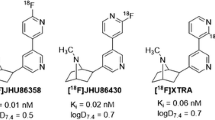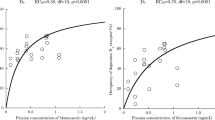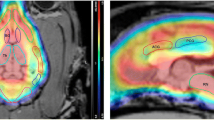Abstract
A comparative evaluation of three radiobrominated butyrophenone neuroleptics — bromospiperone (BSP), brombenperidol (BBP), and bromperidol (BP) — was made to assess the applicability of these compounds as radiopharmaceuticals labelled with the positron emitter 75Br (T 1/2=1.6 h) for mapping cerebral dopaminergic receptor areas non-invasively with positron emission tomography (PET). BSP, BBP, and BP were prepared in high specific activities with high radiochemical yields, using electrophilic reactions with no-carrier-added 77Br- or 75Br-. Screening tests in rats using 77Br-labelled compounds indicated D2-specific localization for 77Br-BSP and 77Br-BBP, whereas PET experiments in baboons showed that only 75Br-BSP preferentially localized in cerebral tissues rich in dopaminergic receptors. The data suggest an inverse relationship between cerebral uptake and receptor-specific localization, which was attributed to a complicated interplay between the D2 receptor binding affinity, lipophilicity, % ionization and molecular weight of the radioligand, and the binding capacity of the cerebral tissues. 75Br-BSP gave a striatumto-cerebellum ratio of 3 in baboon brain 5 h post-injection, which allowed visualization of dopaminergic-receptor-containing areas of the living brain using PET.
Similar content being viewed by others
References
Arnett CD, Fowler JS, Wolf AP, Logan J, Mac Gregor RR (1984) Mapping brain neuroleptic receptors in the live baboon. Biol Psychiat 19:1365–1375
Arnett CD, Shiue C-Y, Wolf AP, Fowler JS, Logan J, Watanabe M (1985a) Comparison of three 18F-labeled butyrophenone neuroleptic drugs in the baboon using positron emission tomography. J Neurochem 44:835–844
Arnett CD, Fowler JS, Wolf AP, Shiue C-Y, McPherson DW (1985b) [18F]-N-methylspiperone: the radioligand of choice for PETT studies of the dopamine receptor in human brain. Life Sci 36:1359–1366
Blessing G, Weinreich R, Qaim SM, Stöcklin G (1982) Preparation of 75Br and 77Br via the 75As(3He, 3n) 75Br and 75As(α, 2n) 77Br reactions using Cu3As-alloy as a high-current target material. Int J Appl Radiat Isot 33:333–339
Blessing Q, Qaim SM (1984) An improved internal Cu3As-alloy cyclotron target for the production of 75Br and 77Br and separation of the by-product 67Ga from the matrix activity. Int J Appl Radiat Isot 35:927–931
Brown HC, McDaniel DH, Häflinger O (1955) Dissociation Constants. In: Braude EA, Nachod FC (eds) Determination of Organic Structures by Physical Methods. Academic Press, New York, pp 567–662
Burt DR, Creese I, Snyder SH (1977) Antischizophrenic drugs: chronic treatment elevates dopamine receptor binding in brain. Science 196:326–328
Christensen E, Moller JE, Faurbye A (1970) Neuropathological investigation of 28 brains from patients with diskinesia. Acta Psychiatr Scand 46:14–23
Coenen HH, Moerlein SM, Stöcklin G (1983) No-carrier-added radiohalogenation methods with heavy halogens. Radiochim Acta 34:47–68
Crawley JCW, Smith T, Veall N, Zanelli GD, Crow TJ, Owen F (1983) Dopamine receptors displayed in living human brain with 77Br-p-bromospiperone. Lancet II:975
Ell PJ, Holman BL (eds) (1982) Computed Emission Tomography. Oxford University Press, Oxford
Farrokhzad S, Diksic M (1985) The synthesis of no-carrier-added and carrier-added 18F-labelled haloperidol. J Lab Comp Radiopharm 22:721–733
Friedman AM, Huang CC, Kulmala HA, Dinerstein R, Navone J, Brunsden B, Gawlas D, Cooper M (1982) The use of radiobrominated p-bromospiroperidol for γ-ray imaging of dopamine receptors. Int J Nucl Med Biol 9:57–61
Glowinski J, Iverson LL (1966) Regional studies of catecholamines in the rat brain I. J Neurochem 13:655–669
Hafkenscheid TL, Tomlinson E (1984) Relationships between hydrophobic (lipophilic) properties of bases and their retention in reversed-phase liquid chromatography using aqueous methanol mobile phases. J Chromatogr 292:305–317
Howlett DR, Nahorski SR (1978) A comparative study of [3H]haloperidol and [3H]spiroperidol binding to receptors on rat cerebral membranes. FEBS Lett 87:152–156
Huang CC, Friedman AM, So R, Siminovic M, Meltzer HY (1980) Synthesis and biological evaluation of p-bromospiperone as a potential neuroleptic drug. J Pharm Sci 69:984–986
Janssen PAJ (1973) Structure-activity relationships (SAR) and drug design as illustrated with neuroleptic agents. In: Cavallito CJ (ed) International Encyclopedia of Pharmacology and Therapeutics. Pergamon Press, Oxford, pp 37–73
Kilbourn MR, Welch MJ, Dence CS, Tewson TJ, Saji H, Maeda M (1984) Carrier-added and no-carrier-added syntheses of [18F]spiroperidol and [18F]haloperidol. Int J Appl Radiat Isot 35:591–598
Kuhar MJ, Murrin LC, Malauf AT, Klemm N (1978) Dopamine receptor binding in vivo: the feasibility of autoradiographic studies. Life Sci 22:203–210
Laduron PM, Leysen J (1977) Specific in vivo binding of neuroleptic drugs in rat brain. Biochem Pharmacol 26:1003–1007
Lee T, Seeman P, Tourtellotte WW, Farley IJ, Hornykeiwicz O (1978) Binding of 3H-neuroleptics and 3H-apomorphine in schizophrenic brains. Nature 274:897–900
Leysen JE, Gommeren W, Laduron PM (1978) Spiperone: a ligand of choice for neuroleptic receptors. 1. Kinetics and characteristics of in vivo binding. Biochem Pharmacol 27:307–316
List SJ, Seeman P (1981) Resolution of dopamine and serotonin receptor components of [3H]spiperone binding to rat brain regions. Proc Natl Acad Sci USA 78:2620–2624
Mazière B, Loc'h C, Hantraye P, Guillon R, Duquesnoy N, Soussaline F, Naquet R, Comar D, Mazière M (1984) 76Br-Bromospiroperidol: a new tool for quantitative in-vivo imaging of neuroleptic recptors. Life Sci 35:1349–1356
Mintun MA, Raichle ME, Kilbourn MR, Wooten GF, Welch MJ (1984) A quantitative model for the in vivo assessment of drug binding sites with positron emission tomography. Ann Neurol 15:217–227
Moerlein SM, Stöcklin G (1984) Radiosynthesis of no-carrier-added 75,77Br-brombenperidol. J Lab Comp Radiopharm 21:875–887
Moerlein SM, Laufer P, Stöklin G (1984a) Synthesis of no-carrier-added radiobrominated N-alkylated analogues of spiperone. J Lab Comp Radiopharm 22:1007–1022
Moerlein SM, Stöcklin G (1985 b) Synthesis of high specific activity [75Br]- and [77Br]bromperidol and tissue distribution studies in the rat. J Med Chem 28:1319–1324
Moerlein SM, Laufer P, Stöcklin G (1985 c) Effect of lipophilicity on the in vivo localization of radiolabelled spiperone analogues. Int J Nucl Med Biol 12:353–356
Norman JA, Drummond AH, Moser P (1979) Inhibition of calcium-dependent regulator-stimulated phosphodiesterase activity by neuroleptic drugs is unrelated to their clinical efficacy. Mol Pharmacol 16:1089–1094
Nys GG, Rekker RF (1973) Statistical analysis of a series of partition coefficients with special reference to the predictability of folding drug molecules. The introduction of hydrophobic fragmental constants (f values). Chim Ther 5:521–535
Nys GG, Rekker RF (1974) The concept of hydrophobic fragmental constants (f-values) II. Extension of its applicability to the calculation of lipophilicities of aromatic and heteroaromatic structures. Chim Ther 9:361–375
Owen F, Cross AJ, Crow TJ, Longden A, Poulter M, Riley GJ (1978) Increased dopamine receptor sensitivity in schizophrenia. Lancet II:223–226
Peroutka SJ, Snyder SH (1980) Relationship of neuroleptic drug effects at brain dopamine, serotonin, α-adrenergic, and histamine receptors to clinical potency. Am J Psychiat 137:1518–1522
Qaim SM, Stöklin G (1983) Production of some medically important short-lived neutron-deficient radioisotopes of halogens. Radiochim Acta 34:25–40
Reisine TD, Fields JZ, Yamamura HI, Bird ED, Spokes E, Schreiner PS, Enna SJ (1977a) Neurotransmitter receptor alterations in Parkinson's disease. Life Sci 21:335–344
Reisine TD, Fields JZ, Stern LZ, Johnson PC, Bird ED, Yamamura HI (1977b) Alterations in dopaminergic receptors in Huntington's disease. Life Sci 21:1123–1128
Seeman P, Ulpian C, Bergeron C, Riederer P, Jellinger K, Gabriel E, Reynolds GP, Tourtellotte WW (1984) Bimodal distribution of dopamine receptor densities in brains of schizophrenics. Science 225:728–731
Shiuc C-Y, Fowler JS, Wolf AP, Watanabe M, Arnett CD (1985) Synthesis and specific activity determinations of no-carrier-added (nca) fluorine-18-labeled butyrophenone neuroleptics benperidol, haloperidol, spiroperidol, and pipamperone. J Nucl Med 26:181–186
Tewson TJ, Raichle ME, Welch MJ (1980) Preliminary studies with [18F]haloperidol: a radioligand for in vivo studies of the dopamine receptors. Brain Res 192:291–295
Thal LJ, Horowitz SG, Dvorkin B, Mackman MH (1980) Evidence for loss of [3H]spiroperidol and [3H]ADTN binding sites in rabbit brain with aging. Brain Res 192:185–194
Wagner HN, Burns HD, Dannals RF, Wong DF, Langström B, Duelfer T, Frost JJ, Ravert HT, Links JM, Rosenbloom SB, Lukas SE, Kramer AV, Kuhar MJ (1983) Imaging dopamine receptors in the human brain by positron tomography. Science 221:1264–1266
Wagner HN, Burns HD, Dannals RF, Wong DF, Langström B, Duelfer T, Frost JJ, Ravert HT, Links JM, Rosenbloom SB, Lukas SE, Kramer AV, Kuhar MJ (1984) Assessment of dopamine receptor densities in the human brain with carbon-11-labeled N-methylspiperone. Ann Neurol 15:S79-S84
Welch MJ, Kilbourn MR, Mathias CJ, Mintun MA, Raichle ME (1983) Comparison in animal models of 18F-spiroperidol and 18F-haloperidol: potential agents for imaging the dopamine receptor. Life Sci 33:1687–1693
Wong DF, Wagner HN, Dannals RF, Frost JJ, Ravert HV, Links JM, Folstein MF, Jensen BA, Kuhar MJ, Toung JT (1984) The effects of age on dopamine receptors measured by positron tomography in the living human brain. J Nucl Med 25:73
Author information
Authors and Affiliations
Rights and permissions
About this article
Cite this article
Moerlein, S.M., Laufer, P., Stöcklin, G. et al. Evaluation of 75Br-labelled butyrophenone neuroleptics for imaging cerebral dopaminergic receptor areas using positron emission tomography. Eur J Nucl Med 12, 211–216 (1986). https://doi.org/10.1007/BF00256924
Received:
Accepted:
Issue Date:
DOI: https://doi.org/10.1007/BF00256924




